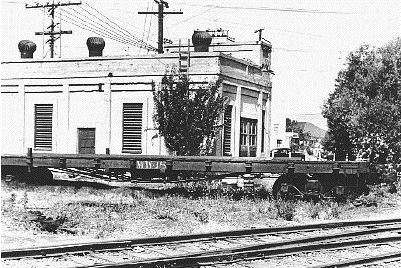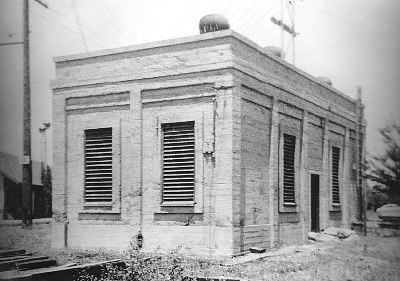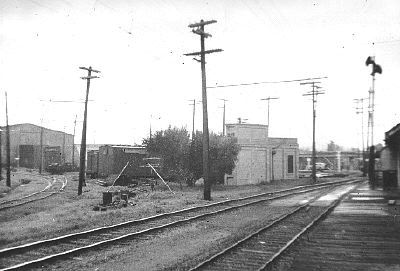ALL ABOUT SN'S CONCORD SUBSTATION
To a teenage boy fascinated with trains, the Sacramento Northern of the early 1950s was a wonder. One of my favorite places on the SN was the substation in my hometown of Concord.
The main star of the substation was the two-bearing motor generator set. The machine included an 11,000 volt AC, 60 cycle, 514 rpm, 3 phase synchronous motor of 1080 horsepower; a 1500 volt, DC interpole generator at 750 kilowatts, plus a 19 kilowatt, 125 volt exciter, all on one shaft. It was a very efficient setup for its size. It wasn't much bigger than the 600 volt DC rotary converter in the SN automatic portable substation #1, now at Rio Vista Junction.

The motor generator set was in the northeast corner of the substation with the generator and the exciter on the north end. Two AC motor panels and switch gear were in the bay in the northwest corner. The automatic controls, motor-driven drum, relays, and timers were on the east wall next to the door. What puzzled me the most was that the motor-driven drum, the heart of the automatic controls, sat on the floor! To enter the substation, you had to step over numerous sand bags that were put in place during the big winter of 1951-1952. Everything else was well off the floor. The concrete floor was never finished or smoothed off.
Along the southeast wall was a motor compressor with a tank to provide air for the electro-pneumatic switches, and in the center of the concrete building were three DC feeder panels and one DC ground panel with the DC electro-pneumatic switches. The south half of the substation was taken up with locomotive resistor grids that limited the output of the unattended substation to a predetermined amount of power so as not to overload it. If there was no load upon the substation for twenty minutes, it would shut itself down automatically. The motor generator set was so well balanced that it would take five to ten minutes to come to a rest upon shutdown.
The Concord substation originally had an operator who had to manually start the machinery when trains approached. After 1929, it was converted to automatic operation. The station would come online when the pressure on the overhead dropped to 1400 volts.
When the motor generator set started, there were two distinct sounds, a buzz like a high voltage short circuit and the sound of escaping air. As the motor generator increased in speed, a high-pitched whine replaced the buzz and air noise. At top speed, the motor-generator hunted in and out of synch, then the D.C. generator cut in on the line with a great clatter and arcing by the electro-pneumatic switches. I didn't have to be in the building to know what was going on. The noise level was well above the anemic sound of portable substation #1 by a wide margin.
Another interesting point about the concrete substation structure is what were originally double-hung windows were converted to horizontal louvers with screens on the inside. This made it a totally open structure. Three turbine ventilators on top gave maximum air flow. The turbine ventilators were covered with canvas during winter months.

This substation was originally set up for 1200 volts, but in 1936 the pressure was stepped up to 1500 volts. To increase the voltage it was necessary to shim the field pole pieces to decrease the air gap between the field poles and armature poles on the DC generator. The Milwaukee Road increased its voltage from 3000 to 3400 volts by using the same means. This decreased line losses due to resistance, and also provided a modest increase in speed and horsepower at the wheel of each train. The 1000 horsepower locomotives (605-606, 660-661) went to 1250 ; 820 horsepower locomotives (650-654, 670) went to 1025; and 480 horsepower locomotives (603-604) went to 600. On passenger cars with traction motors, the Westinghouse 322-E motors increased from 120 horsepower to 150, with an corresponding increase in speed.
Early in 1951 a strange visitor came to the substation spur, SN's automatic portable substation #1. An electrical engineer from Chico came down with the car as the shops there were closing. His job was to set up the portable substation for use at the WP shops in Sacramento where all repairs on SN power would be done after the Chico closure. The portable substation was never hooked up at Concord since it was a 600 volt unit.

The Concord substation closed for good on the afternoon of February 28, 1957 with the end of electric operation on SN's south end. Later that year building was demolished under the direction of SN-TS roadmaster Harold Greer. First the doors, ventilators, louvers, and roof were removed. A truck crane was brought in to lift the motor generator set out, then the concrete shell was demolished with a wrecking ball. Thereafter, Greer parked his company pickup truck on the remaining concrete slab.
In March 1993 the contractor working on the Bay Area Rapid Transit's North Concord extension uncovered the northeast corner of the slab while excavating for a vertical pillar. The slab was covered again during the construction, perhaps for some future generation to discover.
Bob Campbell's description of the Concord substation was originally part of his story, "Sacramento Northern Memories" which was published in the November 1996 Concord Historical Society Newsletter. Special thanks to the Concord Historical Society for permission to reprint the story here.

